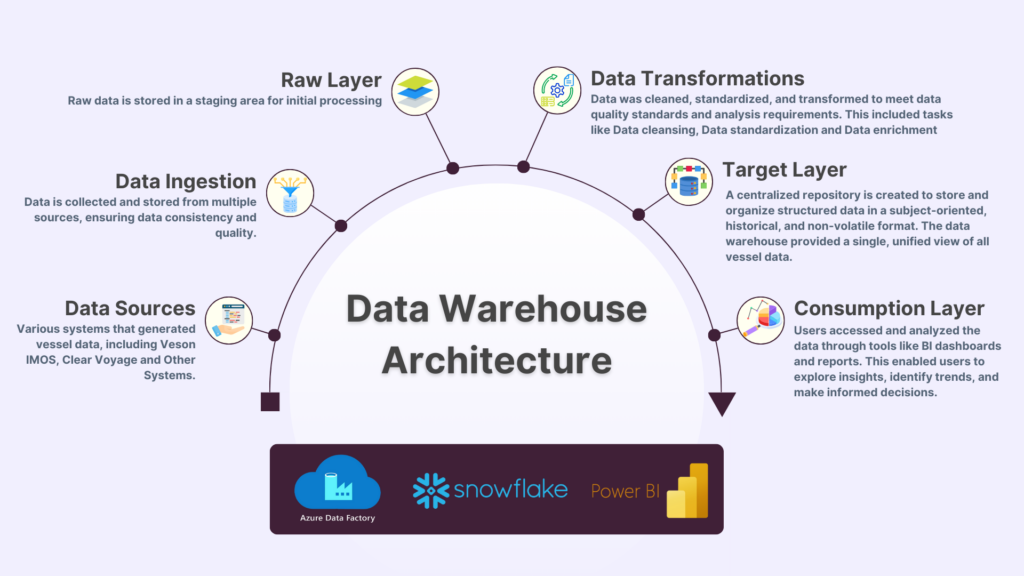Transforming Commercial and Business Operations for a Global Transport and Logistics Company
Introduction
In today’s data-driven maritime shipping industry, understanding the importance of empowering informed decision-making through vessel data analysis is crucial. Our client, a leading multi-national company and the third largest in the logistics industry had complex data challenges that negatively impacted its carrier performance, efficient chartering and route planning, cost, and uncovering market demands.
Through a consultative approach, Hoonartek implemented a multi-tenant data warehouse solution to unlock the potential of their vast data and gain valuable insights for optimized commercial operations. This gave a consolidated view across Finance, Sales, and Business Operations. The outcome was more optimised manpower and financial planning for our client.
The Challenge
Prior to implementing the data warehouse, our client faced limitations with their existing data management system:
- Data Silos: Vessel data was scattered across various systems, hindering comprehensive analysis and integration.
- Slow Data Retrieval: Traditional data storage methods resulted in slow retrieval times, impacting operational efficiency.
- Data Quality Concerns: Inconsistent data formats and potential inaccuracies hampered the reliability of generated insights.
- Lack of Centralized Platform: The absence of a central repository for vessel data hindered data exploration and reporting.
These challenges limited our client’s ability to:
- Optimize vessel performance and fuel consumption.
- Make informed decisions regarding chartering and route planning.
- Identify trends and opportunities for cost reduction.
- Gain a deeper understanding of customer needs and market dynamics.
Enhance your Ability to Efficiently Manage and Leverage Data Assets!
Optimize vessel performance and reduce costs with our data-driven solution. Contact us today!
The Solution
Our client implemented a multi-tenant data warehouse solution built on a secure and scalable architecture leveraging industry-leading technologies:
- Azure Data Factory (ADF): This cloud-based service from Microsoft Azure orchestrates the data extraction and transformation processes. ADF pipelines efficiently extract data from various sources, including the client’s Vessel Operations ERP system (Veson IMOS).
- Snowflake: The data warehouse utilizes Snowflake, a cloud-based data storage platform, to ensure secure, scalable, and cost-effective storage for our client’s vessel data. Snowflake’s architecture allows for separating raw, curated, and presentation layers, facilitating data management and access control.
- Power BI: Microsoft’s Power BI serves as the business intelligence tool. It transforms the raw data into actionable insights through data visualization and report generation, empowering informed decision-making.
Data Warehouse Architecture:

The provided architecture diagram offers a visual representation of the data flow within the solution. Here’s a breakdown of the key components and data flow:
- Data Sources: Represent various sources of vessel data, likely including Veson IMOS and potentially other sources like voyage data or weather data.
- Azure Data Factory (ADF): Orchestrates the data extraction and transformation processes. ADF pipelines handle both the initial loading of historical data and ongoing updates (incremental data) for the data warehouse.
- Raw Layer: Stores the unprocessed data extracted from the various sources in Snowflake.
- Data Quality Checks: Data quality checks are performed, possibly within ADF or a separate data quality tool, to ensure data integrity before loading into the curated layer.
- Enriched Layer (Curated Layer): Refers to the data cleansing and transformation steps within Snowflake. Data is transformed from its raw format into a usable format for analysis using SnowSQL, a query language for Snowflake, and potentially stored procedures.
- Target Layer (Data Warehouse): Represents the final data warehouse storage within Snowflake.
- Data Governance & Security: Snowflake’s security features, including Single Sign-On (SSO), Role-Based Access Control (RBAC), and data masking, ensure secure and controlled data access.
- Data Visualization Framework using Power BI: Business users leverage Power BI reports and dashboards to access and analyze the data stored in the data warehouse.
- External Users (Optional): The architecture can potentially support secure data sharing with external users through designated mechanisms.
- Azure Data Factory & Azure Monitor: ADF orchestrates the data pipelines, while Azure Monitor provides oversight of the data warehouse processes, including data ingestion and transformation tasks.
Outcomes:
By implementing the multi-tenant data warehouse solution, our client achieved significant improvements:
Increased Efficiency
- Azure Data Factory streamlines data extraction and transformation, leading to significantly faster data retrieval times and enabling faster analysis and quicker decision-making.
Enhanced Data Quality
- The data quality framework and Snowflake’s data governance features ensure reliable and trustworthy data, leading to more accurate insights.
Data-Driven Decision Making
- Easy access to clean, integrated, and secure data empowers our client to make informed decisions regarding vessel operations, chartering, and overall business strategy.
Improved Operational Performance
- With better data insights, our client can optimize vessel performance, potentially leading to fuel cost savings and improved efficiency.
Conclusion
The successful implementation of the vessel commercial operations data warehouse for our client exemplifies the power of data analytics in the maritime shipping industry. By leveraging a secure, scalable, and multi-tenant solution built on Azure, Snowflake, and Power BI, our client is now well-positioned to optimize their commercial operations and gain a competitive edge through data-driven decision making.
This data warehouse solution empowers them to:
- Gain a 360-degree view of their vessel operations, enabling them to identify trends, optimize resource allocation, and make data-backed strategic decisions.
- Improve operational efficiency by streamlining data access and analysis, leading to faster response times and reduced operational costs.
- Enhance collaboration across departments by providing a central platform for data sharing and analysis, fostering better decision-making across the organization.
- Future-proof their data infrastructure with a scalable and adaptable solution that can accommodate future growth and evolving data needs.
This case study demonstrates the significant value that a well-designed data warehouse solution can bring to the maritime shipping industry. As data continues to be a critical asset, companies that embrace data-driven decision making can gain a significant advantage in this competitive landscape.


